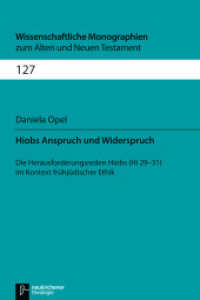- ホーム
- > 洋書
- > 英文書
- > Nature / Ecology
Full Description
This book offers a multidisciplinary analysis of the degradation process of an ecosystem, drawing upon the Mar Menor as a case study to highlight the damage human pressure causes to the environment.
All ecosystems change over time, although in some cases, this variation is more dynamic and evident. The Mar Menor is a clear example of this "ecological transition", as it is the largest coastal lagoon in the western Mediterranean and the first ecosystem in Europe to be granted legal personhood rights. This book provides an extensive overview of the history of its environmental degradation over the past 100 years, highlighting the subsequent succession of environmental crises including phytoplankton explosions, the disappearance of large areas of submerged meadows due to eutrophication, and episodes of mass mortality of aquatic fauna. Split into three sections to reflect thematic blocks, the book begins with a comprehensive description of the Mar Menor and its marine ecosystems, emphasizing its ecological value and unique space in Spain and Europe. It discusses intensive and globalized agriculture, surrounding agro‑export, and the laws that legislate it. In the second part, the book draws on a series of cultural concepts, theoretical frameworks, and participatory arts‑based research to enrich our understanding of the environment from multiple perspectives. Finally, in the third part, the book uses analysis gathered from the Mar Menor case study to discuss wider conclusions about the ways in which we can begin to undo our damage to the environment and restore ecosystems.
This book will be useful for students, academics, and researchers interested in environmental justice, environmental history and anthropology, sustainable development, and environmental studies more broadly.
Contents
List of contributors
Foreword
Introduction
1 The Mar Menor - the transition of an ecosystem over time (its crises in the last 200 years)
2 Ecosystems and biodiversity in the frontiers of the Mar Menor Lagoon: birds as alert bioindicators of environmental change
3 Agrarian reason, deep histories and environmental destruction in the Campo de Cartagena‑Mar Menor: a Gramscian world‑ecology perspective
4 The ecological degradation of the Mar Menor. Power, science and deep stories in Global agriculture
5 Impacts of mining in the Sierra Minera on the Mar Menor lagoon
6 Cultural landscapes' deterioration as losing one's aesthetic environment: the case of Mar Menor
7 Monstrous lagoon: creatures of art and science in the Mar Menor
8 A citizen assembly for transitioning the Mar Menor?
9 The rights of Nature and the case of the Mar Menor. Implementation of Law 19/2022 of 30 September and enforcement in the judicial sphere
10 The Mar Menor (Spain) and incipient European regulations: from ecological restoration to agricultural flexibility
11 La Manga del Mar Menor. Architecture for environmental colonisation
12 The assembly of the gaze: composing wetlands in a glocal world
13 Thick Presents. Stories for an ecosocial transition
14 Capital against nature: accumulation by dispossession and externalization in the Mar Menor
15 Minor emotions: how to live in a damaged environment
Index








